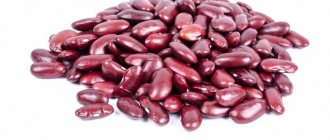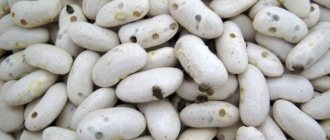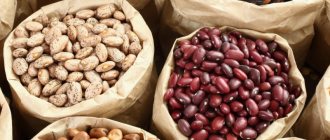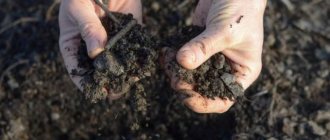Why are beans sprouted?
Adherents of proper nutrition recommend eating sprouted sprouts of various crops, including beans. They contain a large amount of vitamins and microelements necessary for the body. The food used is small green mung beans called peas. Salads, stews, and cutlets are prepared from it. The procedure for sprouting beans is carried out for several reasons:
- When sprouting, sugars that contribute to bloating are decomposed.
- The amount of healthy protein in grains increases by 30%, the amount of carbohydrates decreases by 15%.
- The carcinogen aflatoxin is deactivated.
- The number of enzymes increases 100 times.
- Eating bean sprouts helps eliminate toxins.
If the legume crop is not used for eating raw, but as planting material, germination will help the seeds germinate quickly. The gardener will be able to harvest the harvest earlier than when planting beans without sprouts.
Seed stratification
The seeds of many temperate latitude plants acquire the ability to germinate only after a period of being in a cold and damp place. This is necessary to prevent seed germination in the fall. Otherwise, the cold will kill the seedlings.
Stratification is the long-term retention of seeds at low temperatures.
Freezing occurs at different temperatures for different plant species. So, for a tomato it is -1, and for barley - -10.
Bibliography
- Biology. Bacteria, fungi, plants. 6th grade: textbook. for general education institutions / V.V. Beekeeper. – 14th ed., stereotype. – M.: Bustard, 2011. – 304 p.: ill.
- Tikhonova E.T., Romanova N.I. Biology, 6. – M.: Russian Word.
- Isaeva T.A., Romanova N.I. Biology, 6. – M.: Russian Word.
Additional recommended links to Internet resources
Homework
- Biology. Bacteria, fungi, plants. 6th grade: textbook. for general education institutions / V.V. Beekeeper. – 14th ed., stereotype. – M.: Bustard, 2011. – 304 p.: ill. - With. 186, tasks and questions 5, 7 (Source).
- What is seed swelling?
- What conditions are necessary for seed germination?
- * Think about how the seed of a dicotyledonous plant, deprived of one of the cotyledons, will develop? How will the seed of a monocot plant lacking endosperm develop? Will there be any development at all in these cases? Justify your answer.
If you find an error or broken link, please let us know and contribute to the development of the project.
Preparing beans for sprouting
Before soaking, the seeds are sorted, rejecting substandard ones. Blackened, beetle-eaten dry beans are removed. Such seeds will still not be able to germinate, but will only take up space in the dishes. The beans are then thoroughly washed, especially if they are being sprouted for consumption. For 4-5 hours it is placed in a bowl with water to swell, then germinated using one of the selected methods.
Advice! In order for the beans to germinate faster, they need to be kept in water for 4-5 hours to swell.
Presentation on the topic: "Conditions and stages of bean germination. Galkin Vsevolod, 2a.” — Transcript:
1 Conditions and stages of bean germination. Galkin Vsevolod, 2a
2 Beans Beans are a plant of the Legume family.
3 Dry beans in a warm place The bean seeds have not changed. There was no germination.
4 Beans, completely in water and in a warm place The bean seeds have absorbed the water and swelled. There was no germination.
5 Beans in a wet cloth in the refrigerator The bean seeds have absorbed water and swelled. There was no germination.
6 Beans in a wet cloth in a warm place The bean seeds swelled and sprouts appeared on the third day.
7 On the fifth day, the root, stem, and leaves appeared. The sprouted bean seeds were planted in the ground.
8 On the seventh day a shoot appeared from the ground.
9 On the ninth day, the height of the sprouts was about six centimeters.
10 Conclusions: Bean seeds germinate under the following conditions: 1. Water; 2. Air; 3. Warmth; 4. Light.
Basic methods of germination
Beans are sprouted both for consumption and for planting in open ground. Each option has its own nuances.
How to quickly sprout beans for food
There are several ways to germinate legumes for food. With any of the methods, the grains swell overnight, and after 1-2 days the first seedlings appear. First, the seeds are soaked in water for several hours, then germination will occur faster.
In damp cloth
The beans are laid out on a moistened material and covered with the same layer of cloth. Every 2-3 hours, the legume is moistened with water from a spray bottle. When moistening, you need to make sure that there is no excess liquid on the surface. Because of this, the seeds stop breathing and may become moldy.
In a glass container
Sprouting beans in a glass container at home in stages:
- The washed seeds are placed in a glass jar.
- Cover the container with damp gauze or other cloth.
- Then the dishes with beans are placed in a warm place.
Twice a day - morning and evening, the beans need to be washed, then put back into the jar. When using this method, there is no excess moisture in the dishes, as a result of which heat exchange is not disrupted and the seeds do not become moldy.
On cotton pads
First, cotton pads or balls are placed in the dishes, and beans are placed on them. Everything is moistened with a small amount of water. The container is placed in a warm place. Seedlings appear the next day.
Read also: Altai phoenix apple tree description photo reviews
Germination of bean material for planting in the ground
For planting in the ground, several options for soaking seeds are also used. Germination begins after 2 days. The grains begin to germinate a few days before planting in open ground. First, they are washed, soaked for several hours in water, then in a weak solution of potassium permanganate to prevent fungal diseases.
In a rolled-up cigarette
The procedure is performed as follows:
- A roll of toilet paper is spread on the film, which is then sprayed with water from a spray bottle.
- The beans are laid out at a distance of several centimeters from one another.
- A layer of paper is laid on top, which is then moistened.
- The film is rolled up and the bottom edge is dipped into water.
After a few days, the beans are ready for planting.
In the dishes
For germination, use a colander, deep bowl, and gauze. The procedure is performed as follows:
- Gauze is placed inside the colander.
- seed spills out.
- The top of the beans is covered with gauze.
The legume crop is watered from above with water, the excess of which flows through the holes into the bowl. You need to make sure that the gauze on top is wet all the time.
In peat pots
Young seedlings do not tolerate transplantation well, so beans can be planted in peat pots with moist soil. When they grow up, they are planted in open ground along with pots. As peat decomposes, it will serve as additional nutrition for the root system.
School experiences
In a biology lesson, schoolchildren conduct various experiments, one of which is the correct sprouting of beans. To do this, use a nylon lid, cotton pads, and beans from the store. Germination procedure step by step:
- Wet discs are placed in the lid.
- Then the grains are laid out in one layer.
- The beans are covered with cotton pads, which are moistened with water.
You need to ensure that the discs are kept wet at all times, but without stagnating liquid. Within a couple of days, sprouts will appear.
How to germinate mung bean
Mung beans are small green beans. We used to call it peas. The principle of germinating mung beans is not much different from beans. Pea sprouts are consumed as a main dish, salads, stews and even cutlets are prepared from it. This product is extremely beneficial for the body.
Note! For germination, only fresh mung bean harvest is used. Otherwise, the beneficial properties of the sprouts are significantly reduced.
In order for mung bean to germinate, it must first be soaked in cold water. After 10 hours, the peas are removed, washed and filtered through a sieve. Soaked beans will become softer and increase in volume, which will speed up the emergence of seedlings.
The best way to germinate mung beans is in a small plastic bucket with holes drilled in it. This will prevent excess water from being in the container, which could cause the grains to turn sour.
Dry gauze is placed at the bottom of the bucket. Grains are poured on top of it and sprinkled with water. Then they are covered with a cloth and placed in a dark place for a day. Every 2-3 hours you need to add a little water to the mung bean. Within a day, small sprouts will appear, which can be eaten immediately or left for another 2-3 days to achieve greater length.
Bean care
As soon as the beans sprout, the bed is watered with water, then the soil is loosened. The procedure is carried out carefully so as not to damage the fragile seedlings. Subsequently, loosening is combined with weeding. Water the beans so that the soil is moist but not wet. Moisture is especially needed during the formation of pods. 25-30 days after seed germination, young plants are fed with complex mineral fertilizer. The next feeding is after 20 days.
To prevent plantings from being affected by fungal diseases, it is necessary to observe crop rotation, disinfect seeds, and burn infected bushes.
Pests in the form of snails and slugs are collected by hand. Climbing varieties of beans need to be tied to supports so that they do not break from the wind.
Note! Before fertilizing the planting, it is spilled with plain water, otherwise the delicate roots may be burned by the salts.
Seed germination process
Germination is the process of a seed transitioning from a dormant state to the vegetative growth of the embryo and the formation of a seedling from it.
Only seeds in which the embryo is kept alive are capable of germinating (see Fig. 1).
Rice. 1. Seed structure
Seeds may become unviable under the influence of pests, diseases, temperatures, high humidity, or too long storage.
Swelling is the process of a plant absorbing incoming water and precedes germination.
After swelling, the young root breaks the skin and comes out. Then the embryonic stalk begins to grow and carries the cotyledons above the soil surface (aboveground type of germination). This occurs in beans, pumpkins, and maples. From the embryonic bud the aboveground stem and true leaves develop.
In peas and oak, the cotyledons remain in the soil (underground type of germination). The aboveground shoot develops from the bud of the embryo.
Planting germinated material in the ground
The seeds should not be allowed to outgrow, otherwise the roots will begin to intertwine with each other. When separated, fragile seedlings may break, which will affect the germination of grains. Beans are planted in the second half of spring. By this time the earth is warming up, and the threat of return frosts has passed. This is important because the legume crop is not frost-resistant; even minor frosts can destroy it. The place for planting beans is chosen to be well-lit, with loose, breathable soil. The grains are planted sideways in the ground so as not to damage the roots.
Holes are dug 5-6 centimeters deep, watered, seeds are placed in them, and covered with earth. The distance between plantings is 20-30 centimeters. If the grains are planted in dry soil, there is no need to germinate them.
Additional Information. According to popular wisdom, beans can be planted after the chestnuts begin to bloom.
Day three
The first sample exceeded all our expectations. During the night it rose another 5 centimeters, and during the day the first pair of leaves unfurled, the leaves became larger and the color darker. Between the first pair of leaves there was a sprout for further growth. Through the glass of the jar, the elongated roots of the white plant are visible. In the second sample, the bean barely rose in the ground. Compared to the first sample, the lag is two days. The third sample never changed.
In the first sample, the first pair of leaves increased. The cotyledons gradually dry out and are about to fall off. The root system has grown and filled the free space in the jar. The sprout in the second sample was never able to rise above the ground. In the third sample, growth stopped completely.
Why can't bean seeds be sprouted in soil?
You cannot germinate seeds that are used for food in the soil. In addition, beans sown in a box for seedlings will not tolerate transplantation well. For this reason, if a gardener wants to get an early harvest, the seeds need to be planted in peat pots, which are then planted in open ground. In the southern regions, they often practice planting without soaking, planting beans with the onset of heat in the grooves, which in this case do not need to be moistened.
- home
- List of sections
- The world
- Growing beans











